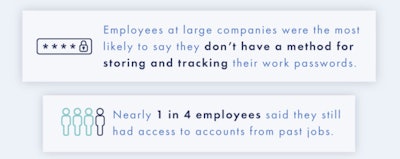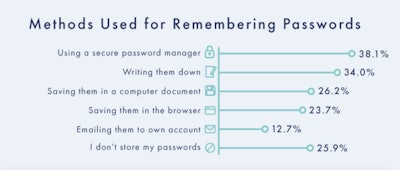
Here’s a punch in the gut: it’s highly likely that former employees still have access to their emails and accounts at your workplace. According to a new report by Beyond Identity, nearly one in four employees said they still have access to accounts from past jobs. But that’s not all. Check out these other stats from the report:
- 41.7% of employees admitted to having shared workplace passwords.
- 42.5% of employees felt that sharing work passwords should be a fireable offense.
- More than 1 in 5 employees said they used the same password for their personal bank accounts as they did for work-related accounts.
Cyberattacks on business, government organizations and other groups are up by the thousands, according to the FBI, increasing awareness and action by employers around the globe.
So just how safe is your company? Judging by the recent report by Beyond Identity, workplace password sharing is common among employees. The company surveyed more than 1,000 current employees about their password habits and tendencies. Survey questions included:
- How secure do they think their passwords are, and how do they keep track of them?
- Do they use the same password for multiple platforms or accounts?
- Does their company have any password-related policies?
Most survey respondents reported that they weren’t too worried about the safety of their passwords, as just over 45% believed they were very secure, and another 26.3% said they felt their passwords were extremely secure. Although many employees admitted to remembering their secure passwords through not-so-secure methods.
 Beyond Identity
Beyond Identity
Remember Passwords
Thirty-four percent of people opted for the old-fashioned system, jotting their passwords down in a notebook or on a scrap of paper. Recording them digitally was a popular option, as well. Meanwhile, over a quarter of employees relied solely on their memory to keep track of passwords, according to the report.
Watch a video about passwords:
Over 38% of employees reported using a password manager, which is a software application that stores and manages online credentials. They’ve been touted as beneficial because they can auto-generate passwords, save time during login processes, and help protect people’s identities, says Beyond Indentity. However, passwords are not 100% unhackable, which means that if infiltrated, password managers give cyber thieves a person’s entire collection of passwords at once.
While there are multiple ways to ensure password protection, nearly one in four people said they are still able to log in to accounts from previous jobs, granting them access to information that they don’t need and shouldn’t be able to see.
Since a resentful ex-employee could use this privilege to wreak havoc, managers should be mindful of this when anyone leaves their company. The difficult task for large organizations is figuring out how to manage their operations both as efficiently and securely as possible to maximize productivity and to minimize risk.
Sharing Passwords
Passwords can pose security problems, and those risks only increase as more people have access to them.
Almost 42% of employees admitted to sharing their workplace passwords with others, and employees at midsized companies (50–249 employees) were the most likely not to keep them a secret.
Two-thirds of employees shared their passwords with co-workers, and many also gave their family members or significant other access to their work information. Sharing passwords via email, orally, and by text were the most common ways that people went about it.
Read the rest of the report here.


















